I’ve been wanting to interview Paul Hoppe for some time and it’s surprising I haven’t…

Interview: Kyle T. Webster
In the first of my new recurring interviews feature, I’m happy to welcome Kyle T. Webster. Kyle’s an illustrator and educator whose clients include The New Yorker, Time, The NY Times, IDEO, NPR, The Atlantic, WIRED, Microsoft, ESPN, Krispy Kreme, BBDO, The Wall Street Journal, Scholastic, Simon and Schuster, and The Washington Post to name a select few. He’s also well known as the creator of Kyle’s Brushes, which brings realistic, high-quality brushes to Photoshop.
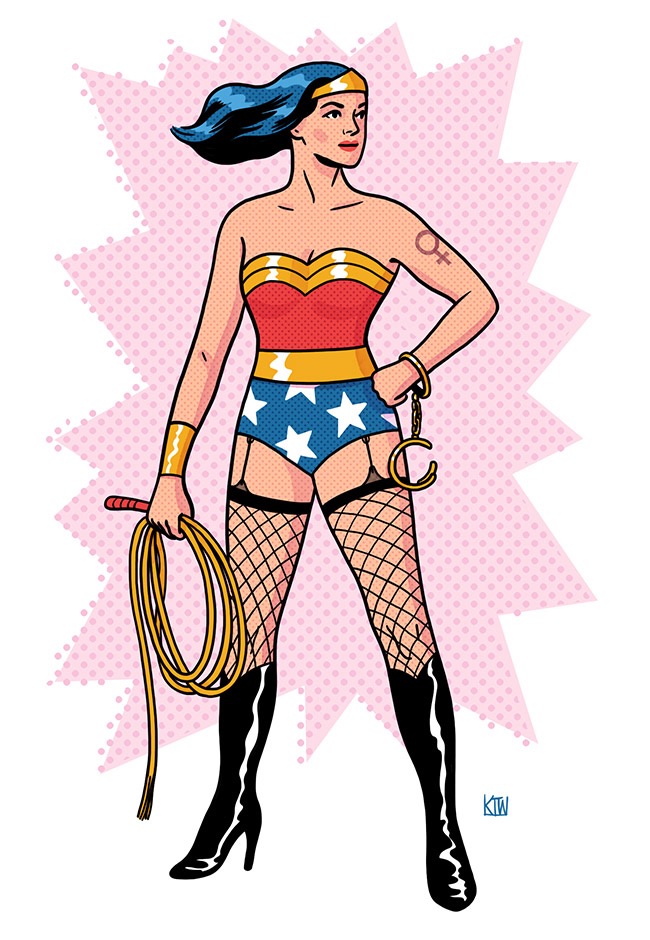 Thanks for agreeing to the interview, Kyle! First, the basics. Where did you study art? What’s your degree in? Any particular formal training?
Thanks for agreeing to the interview, Kyle! First, the basics. Where did you study art? What’s your degree in? Any particular formal training?
I have a BFA in painting and minor in French from the University of North Carolina, Greensboro. I also studied drawing, painting and printmaking at Yale and The University of Rennes 2, in France, and was lucky enough to take part in a week of the Illustration Academy as a professional student with Gary Kelley, who is my hero in the business.
Where do you live? What’s your workspace like?
I live in North Carolina and have an office on the campus of the University of North Carolina School of the Arts, where I do my illustration work. I used to have a home office and a studio downtown, but I have simplified everything and I’m happier for it!
Illustration life can get a bit lonely and isolating. How do you deal with the long stretches of being by yourself all the time?
I work alone, but teaching takes care of the loneliness. I am very fortunate to have a full load of classes to teach (three per semester) and they are all different and interesting. I teach Life Drawing, Drawing 1, Portraiture, Digital Painting, Drawing II, and Watercolor Fundamentals. These responsibilities only occupy ten hours of my week, so I have plenty of time to work on my assignments and my personal projects and other businesses.
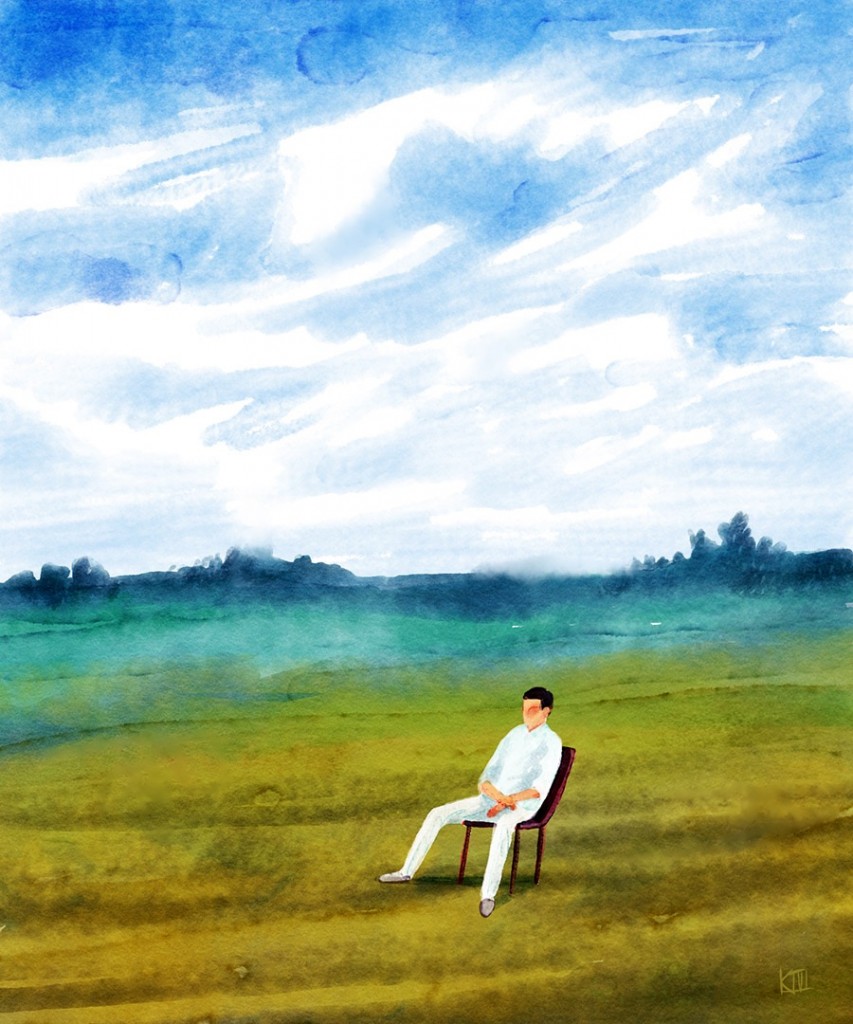 That’s great to hear. And I know you have a lot of things you’re involved in. How long did it take you to become a full-time illustrator? What did you do before then?
That’s great to hear. And I know you have a lot of things you’re involved in. How long did it take you to become a full-time illustrator? What did you do before then?
When I graduated college, I walked right into a web design job, followed by two more of the same. Then, I was hired on as a graphic designer / in-house illustrator for a wonderful firm in town (shapirowalker.com) and I learned the business chops on that job. I quit that full-time job in the middle of my eighth year out of school (2006), and I have been on my own ever since.
What was that transition like? How did you know the time was right to go full-time freelance?
I was literally getting sick to my stomach every morning before work because I knew I was not doing what I wanted with my life/career. I would take Pepto and sit in the bathtub for about an hour each morning and then show up to work late, without being able to explain what was happening. Fortunately, my wife could see the solution right there in plain view, and she urged me to quit. I was aching to just make a go of it on my own, and she helped me bite the bullet. The moment I quit, my stomach aches vanished and I felt liberated. Besides, I was already making more money on freelance work than my full-time salary was paying, so I was confident that the transition would be smooth (I had been accepting outside jobs for four years at that point and had built up a good client list and been in the right shows, annuals, etc.). My confidence was high.
Would you recommend graduating students get a day job while pursuing illustration like you started off or just go for it and try to illustrate full-time?
Some people have strong opinions about this, myself included! I highly recommend full-time work, so you can get some money in the bank and start your life with solid financial footing. But, I only recommend full-time work if the work, itself, is related to what you want to do eventually when you go out on your own. Being a graphic designer and in-house illustrator was the perfect job for me—I was already working in the business, so transitioning into full-time freelancing was an easy jump. Plus, I had enough money saved in the bank to live on for one year, if no jobs came in, which was basically an impossibility anyway, what with the steady flow of editorial jobs I had before quitting. And I had started all my retirement stuff through the jobs I had (401-Ks, etc.). That kind of security makes it easier for you to make good business decisions when you go out on your own—you think more clearly and you don’t act out of desperation (taking low paying gigs, etc.). If you just jump into the pool out of college, I think it’s easier to panic and make some bad mistakes, get overwhelmed, or maybe even give up altogether. But, this is only my opinion—clearly, many people do succeed right out of school. It can be done.
Stepping back a little, let’s talk about pre-career decisions. In general, how important is a traditional arts education for an aspiring illustrator?
I don’t know, really. I think drawing is the big skill. Once you can draw with confidence and with facility, you can make your images do anything you want them to. I personally learned a lot in my four years of college—the education was vital for me. My drawing and painting professors were fantastic. But not all schools have great teachers and not all artists respond the same way to this kind of instruction. I place a high value on traditional art education because it benefitted me so greatly. But I know many people think it is unnecessary in this day of self-directed study through online courses, and so on.
What personality traits do you think are important for an illustrator to have? In other words, what kind of person/temperament makes for a good illustrator?
First of all, I think it’s good to be a bit scared, because that fear makes your survival instinct kick in and you find a way to scrape your way to the top of the heap. If you aren’t scared, then you probably are not feeling any real sense of urgency to get your work out there and get paid. In all the time that I have been doing this job, I have never felt all that relaxed and even though that makes me a bit stressed out, I think it actually has brought me great success. I’m not sure if it’s healthy, though! Second, I think it is important to be kind, friendly, and personable. People like to work with people they like. It’s that simple.
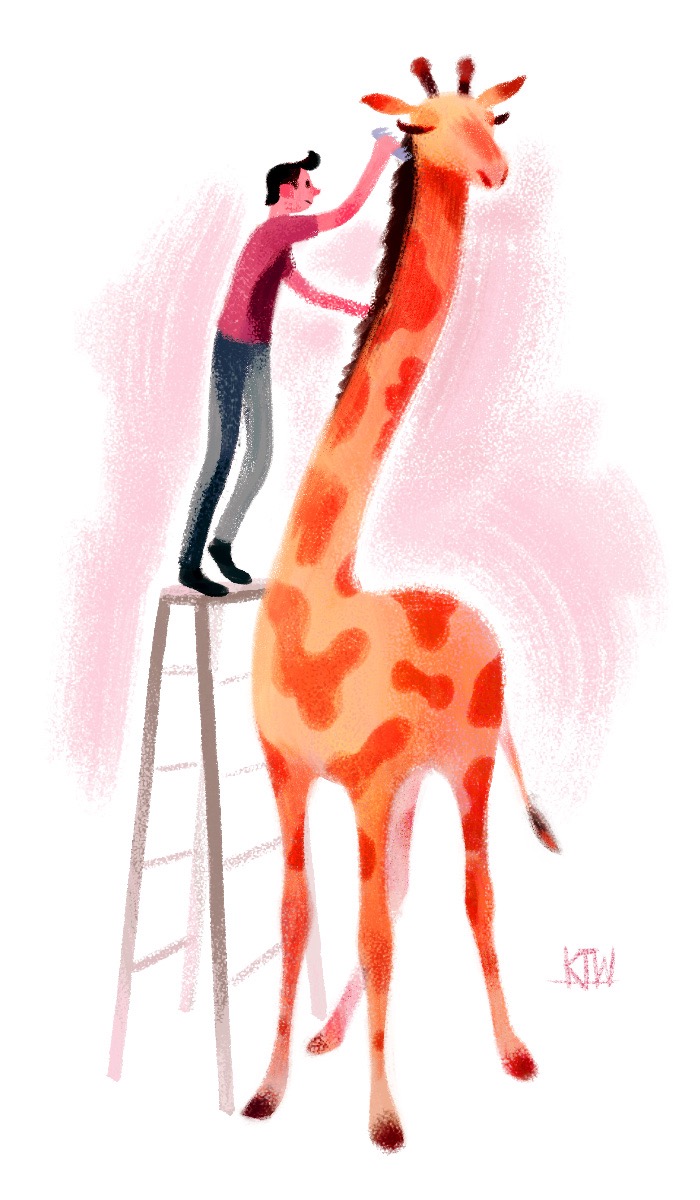 Very true. Speaking of working relationships, what was your first illustration assignment like? Any interesting experiences with it?
Very true. Speaking of working relationships, what was your first illustration assignment like? Any interesting experiences with it?
Well, the first twenty jobs or so were very smooth and easy (spot illustrations and 1/4 pages for various alt weeklies around the country, such as The Stranger, SF Weekly). But my first ‘big’ job was a learning experience. I didn’t read the 20+ page contract and signed away lots of rights. I illustrated a cover and 12 chapter openers for a book and it wound up being published in several languages in new editions, as well as reprinted several times. I only got paid once and the money was not great to begin with. I learned my lesson.
I think we’ve all been there. Another important lesson we learn is dealing with difficult clients. What’s your best strategy for dealing with client feedback that you completely disagree with?
I try to listen very carefully to see if I truly am at fault for having misunderstood the original creative direction. If I have truly failed on what I am to have delivered, I make the changes. If I believe that I stuck to the original plan, I try to help the client see how my solution matches up well with their requirements. If I catch them changing course after we have already agreed on a direction and final art has been produced, I ask for change fees (and these are usually already set in the contract, so I am covered). With editorial work, this can be tricky, but I have had a pretty good record when it comes to asking for extra money for changes after final art, especially when I can prove that my illustration addresses everything that was requested up front. If I have a long-term and very good relationship with a client and they ask for the rare change, I will just go ahead and do it to keep the relationship healthy. I have only fired one client in my career, and it was a blessing.
Ooh, do tell. What drove you to the edge?
Long story short: after agreeing to my fee for a simple advertising illustration and then asking for upwards of five completely new versions of the art without any justification for the changes, I put my foot down and asked to leave the project with a kill fee. Instead of a kill fee, I received an email in which the client called me a <male anatomy>. So, I called them up and fired them over the phone. The funny thing is that they asked me to do another job for them a month later. I reminded them that I never wanted to work with them again. They replied that they didn’t realize I was serious! It was kind of funny, but also kind of unnerving.
 In terms of process, a lot of illustrators listen to music or talk radio while they work. What do you listen to while you’re making your art?
In terms of process, a lot of illustrators listen to music or talk radio while they work. What do you listen to while you’re making your art?
I listen to a million things, but my favorite thing of all is Antioch 1710, a streaming radio station that plays a full day’s worth of old radio shows from the 1930s – 1950s. It’s the best.
Correct me if I’m wrong, but it seems like you work almost 100% digital now (with your amazing brushes, of course). What was that transition like? What made you do the complete switch? Do you have a fancy Cintiq?
I have always worked 100% digitally ever since I got my first freelance job in 2003. Back then, I drew in Flash (before its drawing engine was ruined) and colored in Photoshop. I worked on a 4×5 Wacom Graphire tablet for about five years and then bought a used 6×8 Intuos 4. In 2012, I bought a Cintiq 24HD and I love it a little too much. I look forward to going to work just so I can draw on that thing, even if I don’t have any assignments.
Yeah, those Cintiqs are nice! And I hear your brushes work great on them. For those who don’t know, you’ve made a great secondary income on the side with your brush sets for Photoshop. What was the impetus to start selling them?
Being a digital artist with a good number of years under my belt with various software and tools made the creation of my first set easy because I simply put all of my favorite personal creations into the package. I didn’t really create anything ‘new’ for that first set—I had been making brushes since Photoshop 7, maybe (can’t remember the exact version), so I had plenty of brushes to pull from to make the first Ultimate Set. I noticed that Justin Gerard was selling his brushes about five years ago and I wondered if I could do the same, but then I got busy making apps instead. Finally, I found Gumroad and I knew I could just package everything into a zip file and pop it up on a sales page in less than an hour. So, I went for it. I had absolutely NO idea it would ever lead to having 70,000 customers around the world. It’s surreal.
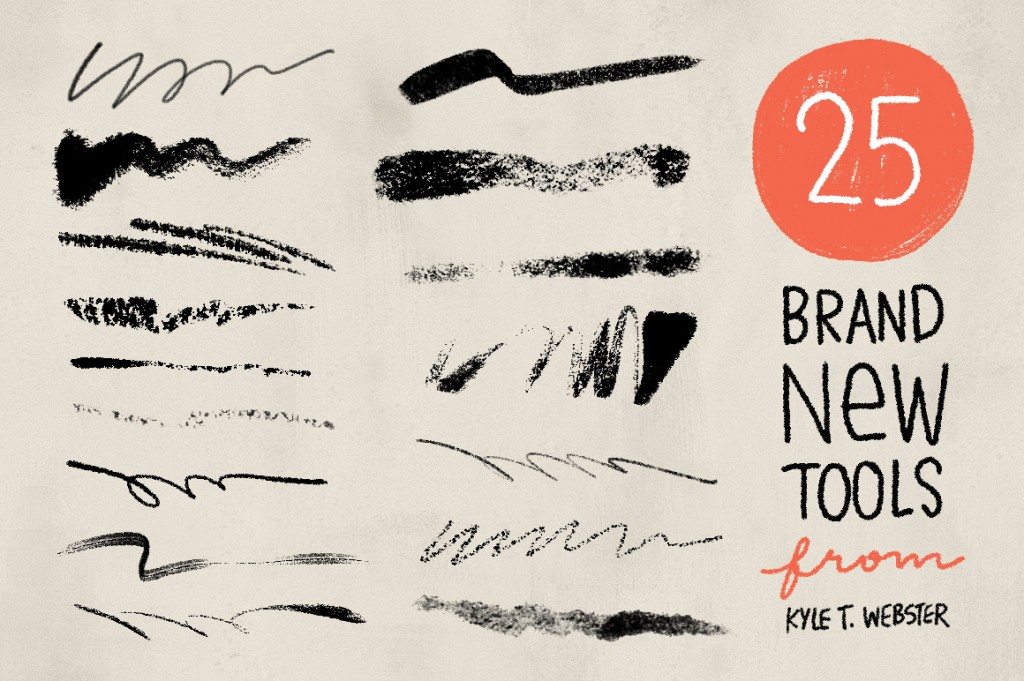
What kind of learning curves did you have to go through to start selling your own brushes? Any big mistakes you made early on that you’d warn others against?
I struggle a lot with pricing. I always think I should have offered my brushes for a bit more money, but I’m not sure. They really are great tools—don’t mean to toot my own horn, but I have tried thousands of brushes and I sincerely believe mine are the absolute best at emulating natural media, especially the watercolors. So, I think they are worth a lot more than what I currently sell them for—perhaps it was a mistake to offer them for so little. But, at the same time, the low price might be what got them moving so fast in the beginning. I really don’t know.
 How have you been promoting your brushes?
How have you been promoting your brushes?
I use social media mostly—lots of tweets, posts on Tumblr, and ads on Facebook. I think the thing that really sells them best is my own illustrations that I create specifically to show off certain brushes and their features. When people see what kind of images are possible with the tools, they are much more inclined to purchase them. I could tell people about them all day long, but showing them a picture is far more effective. I recently started using paid Facebook ads and I have had fantastic results. That surprised me. I also do a lot of sales, promotions, giveaways—the usual stuff that drives traffic. I use email effectively by keeping the emails short and to the point, and the emails always include an offer, a painting tip, or some other free thing that gives it value for the reader.
How do you police against piracy? Is there any way?
I use guilt. That is about all I can do. I see my brushes on all these torrent sites and all I can do is point out that it is truly pathetic and mean-spirited to steal my brushes, when the thieves are usually people who most likely want to be illustrators (or already are working in the business). Where is the logic there? Why steal from your colleagues? Why hurt the very business in which you want so badly to participate? And finally, if you have the means to buy a computer and a drawing tablet, why are you stealing something that costs $14?
Your brushes have become a great source of passive income for you. Can you talk a little bit about that? About the importance of passive income in the career of an illustrator?
I am always looking for ways to make passive income because:
- I don’t want to spend all my time in ‘reaction’ mode—I want to make things and sell them rather than have people asking me to make things and being dependent on their schedules and their budgets.
- I want to have my weekends with my family.
- I want to make as much money as I possibly can in an eight hour day without overworking myself.
- Traditional markets are disappointing me, budget wise (mostly editorial—budgets haven’t moved since I started).
- I want to see how far I can go making products and starting businesses that have almost no overhead costs—the internet is amazing.
- Illustration is unpredictable and having several irons in the fire makes good business sense—I think everybody should sell prints, make apps, make T-shirts, sell comics, etc. just so they always have something cooking.
What’s the future for your brushes? Anything interesting you can talk about?
I have a new site in the works. I am excited to include some great case studies on that site from some amazing artists who have used my brushes on some high profile projects. I will also be creating some paid in-depth instructional videos that will help customers truly get the most out of all of the sets. These videos will also offer general digital drawing and painting tips that are essential for working efficiently in Photoshop. On the new site, I will significantly simplify my current offerings. I plan to reduce everything down to three basic sets: Student, Pro, and Master. I will continue to sell sets a la carte, and I will still have the same free brushes, but I will phase out the individual sets over the course of year. I have received nothing but positive feedback when discussing this with current and prospective customers—I think it’s time! Prices will go up a little for the a la carte offereings, but only by about 10 or 15%. The bundles will offer significant savings. As for new brushes, I am still working on an art marker set, as well as experimenting with new watercolor brushes and effects. My pencil and ink offerings are really solid and the gouache set rounded out all the paints this year, but I may continue to add to those, as well.
And, best of all, I am working on my first picture book with the gouache brushes. I can’t wait to show some of the work, but I am obviously not allowed to do so until my publisher gives me the OK.
When’s Adobe going to license your brushes already?!
If Adobe made me a truly fair and respectable offer, I would gladly discuss selling the whole thing. I frankly think it is in their best interest to legitimately acquire my tool sets because I have been bringing thousands of artists BACK to Photoshop from competing software programs, thanks to the brushes. I get daily emails confirming this. Also, if they bought me out, I could serve as a brush consultant for the company and help the product development team with creating truly revolutionary brush features. I know the limitations of the current engine, and have some great ideas for how to make it even more powerful. There are so many illustrators out there who might use Photoshop, if they knew what it can do—I think Adobe needs help reaching out to them.
Well, I’m rooting for you to make a deal with them. All this business stuff can be tricky. How do you manage splitting the time and brain space between being an illustrator and being a business person? Or even just the business side of illustration vs. the artistic side?
I spend far less time drawing than I ever thought I would. I think my drawing time is down to about 60% of my day. And there are certainly days when I never even pick up the stylus—too many emails, contracts, invoices, plans, and other things to write. But I will say that I am surprised by how much I actually enjoy the business side of the job. Drawing is my first love, and would always rather spend more time on that, but the business stuff can be pretty exciting, especially when I am hatching some new plan to make new products (apps, brushes, whatever). That is a rush. Re: brain space for each activity, I have to admit that is still very hard to bounce back and forth. I seem to do best when I concentrate my drawing time into long bursts rather than interrupting my art to answer emails, etc.—it’s hard to get back into the zone. I think this is pretty normal—I have talked about this with friends.
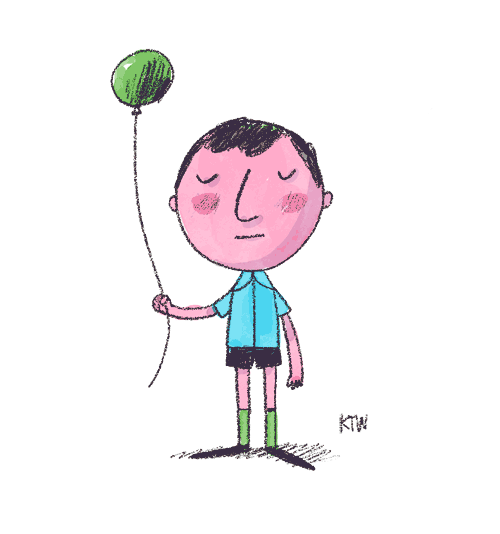 Yeah, it definitely is. So, last question: Since you do so many great things during your business hours, what do you do when you’re not illustrating? Other than sleep!
Yeah, it definitely is. So, last question: Since you do so many great things during your business hours, what do you do when you’re not illustrating? Other than sleep!
I try to be a good Dad, most importantly. Beyond that, I squeeze in some tennis when I can, and small family excursions here and there. I also play golf from time to time (wish I could play more). I love reading comics (mostly French stuff). I have lots of smaller hobbies, but it is hard to find time for them—guitar, saxaphone, and card magic to name a few.
—
Thanks so much to Kyle for his insightful answers! If you want to see more of his work, check out kyleTwebster.com and Kyle’s brushes at kylebrush.com. Also, follow him on Twitter at @kyleTwebster, on Tumbler at kyletwebster.tumblr.com, and on Instagram at instagram.com/kyle.t.webster.
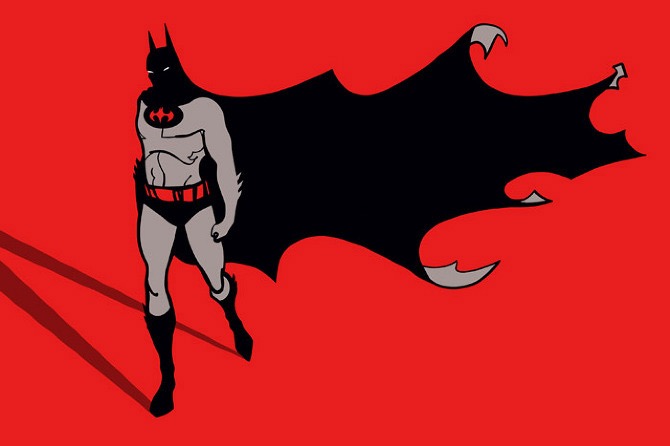


Comments (0)